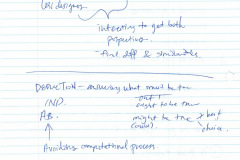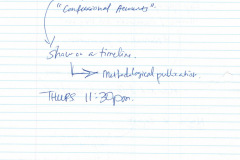
Communities of practice
Topics to discuss:
- Community of Practice vs. Community of Interest
- With UX being a relatively new field, finding a UX CoP may not be as easy as other professions
- I have to identify specific UX domains (issues) that a community of UX designers want to solve for
- I predict knowledge creation and exchange occurs when UX designers come together to solve an issue in the UX domain
- UX domain/issue will lead to the CoP
- So, perhaps I first need to interview UX designers to identify issues that they share across the organization
Questions drawn from reading:
How do design leaders find ways to advocate UX team’s knowledge to the greater organization?
How do UX best practices impact across the whole organization?
What is the value of having UX designers bond well as a group within the organization? How does their bond affect their work and/or the organization’s perception of them?
Do your designers have a CoP within the organization, or is it primarily a Community of Interest for a professional association?
What domains of fundamental design knowledge before joining the organization vs. domain of design knowledge specific to the organization is expected within the community of practice?
How are best practices captures and integrated / passed-on for future use? How do designers determine which best practices to apply?
How would you describe the common characteristics of your most knowledgeable / most skilled designers?
Grounded Theory
Topics to discuss:
- The thought of society being dominated by scientific research is interesting; shift in epistemology
- How to tell the difference between high and low quality GTMs
- Need more clarity on abduction; is it like a transitory process between induction and deduction?
- Basic principles of GTM I gathered:
- Everything is data but data is not everything
- Focus on quality of analysis and de-emphasize importance of data
- Articulate deduction process clearly by describing the full detail of the context in which you conducted research
- Begin data collection and analysis with no pre-determined hypothesis
- Don’t think of data analysis process as a computational process; it is highly interpretive. The interpretations are tested afterwards.
Questions drawn from reading
How is using GTM in my research more suitable than using quantitative methods? Is it because UXD is a new field? There are no numerical scales to use (yet)?
By performing GTM to understand the KM of UX designers, I can understand through multidisciplinary perspectives.
(UX design is also a multidisciplinary profession)
Using GTM for my research suits the context of the research, question, and desired outcome.
My desired outcome:
- Discover and develop novel theory (about KM of UX designers)
- Not building off of an existing theory
- Gathering data without a pre-constructed framework (because UX is a relatively new professional field and is transforming at the pace of technological innovation)
How does this apply in my situation when interviewing designers? What are examples of pre-determined ideas about the KM of UX designers I should leave behind?
How can I prepare myself to use GTM without it seeming naïve and a buzz word as a novice researcher?
How can you tell if GTM was done well? How do you know when GTM was not done well?
How do you tell good researchers apart from the bad? How can you judge a researcher based on how data was collected, assembled, discovered, etc…
How do you judge the quality of something serendipitous?



